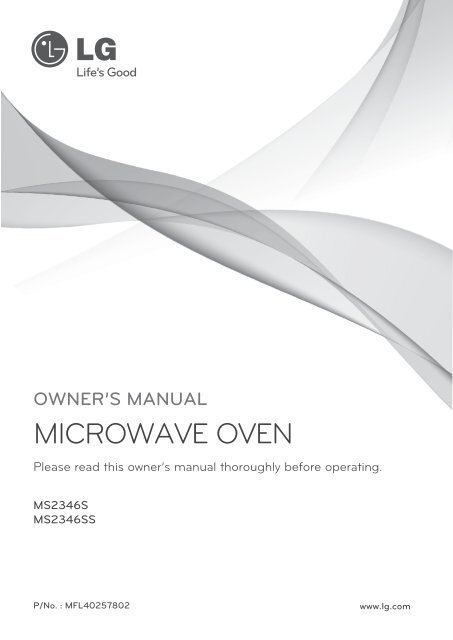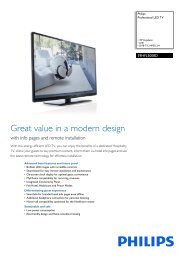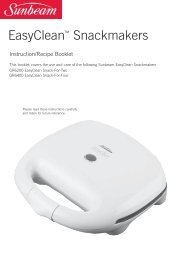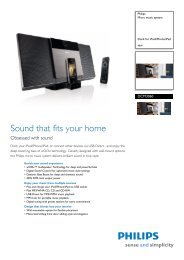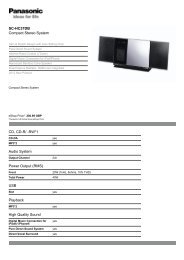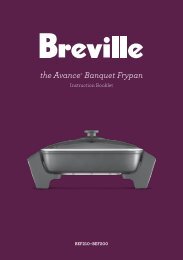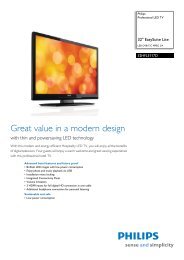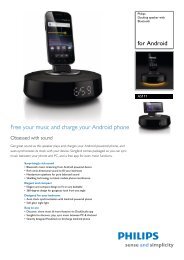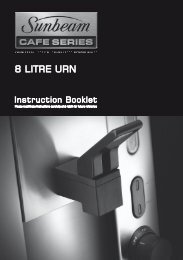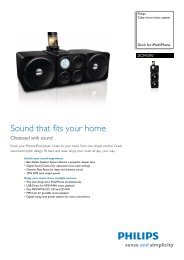MICROWAVE OVEN - Yardley Hospitality
MICROWAVE OVEN - Yardley Hospitality
MICROWAVE OVEN - Yardley Hospitality
Create successful ePaper yourself
Turn your PDF publications into a flip-book with our unique Google optimized e-Paper software.
OWNER’S MANUAL<strong>MICROWAVE</strong> <strong>OVEN</strong>Please read this owner’s manual thoroughly before operating.MS2346SMS2346SSP/No. : MFL40257802www.lg.com
Precautions to avoid possible exposure to excessive microwave energy.You cannot operate your oven with the door open due to the safety interlocks built into the doormechanism. These safety interlocks automatically switch off any cooking activity when the door is opened;which in the case of a microwave oven could result in harmful exposure to microwave energy.It is important not to tamper with the safety interlocks.Do not place any object between the oven front face and the door or allow food or cleaner residue toaccumulate on sealing surfaces.Do not operate your oven if it is damaged. It is particularly important that the oven door closes properly andthat there is no damage to the: (1) door(bent), (2) hinges and latches (broken or loosened), (3) door sealsand sealing surfaces.Your oven should not be adjusted or repaired by anyone except qualified service personnel.WarningPRECAUTIONSPlease ensure cooking times are correctly set as over cooking may result in the FOOD catchingfire and subsequent damage to your oven.When heating liquids, e.g. soups, sauces and beverages in your microwave oven, overheating the liquidbeyond boiling point can occur without evidence of bubbling. This could result in a sudden boil over of thehot liquid. To prevent this possibility the following steps should be taken:1. Avoid using straight sided containers with narrow necks.2. Do not overheat.3. Stir the liquid before placing the container in the oven and again halfway through the heating time.4. After heating, allow to stand in the oven for a short time, stir or shake them again carefully and check thetemperature of them before consumption to avoid burns (especially, contents of feeding bottles and babyfood jars).WarningAlways allow food to stand after being cooked by microwaves and check the temperature ofthem before consumption. Especially contents of feeding bottles and baby food jars.How the Microwave Oven WorksMicrowaves are a form of energy similar to radio and television waves and ordinary daylight. Normally,microwaves spread outwards as they travel through the atmosphere and disappear without effect.Microwave ovens, however, have a magnetron which is designed to make use of the energy in microwaves.Electricity, supplied to the magnetron tube, is used to created microwave energy.These microwaves enter the cooking area through openings inside the oven. A turntable or tray is locatedat the bottom of the oven. Microwaves cannot pass through metal walls of the oven, but they can penetratesuch materials as glass, porcelain and paper, the materials out of which microwave-safe cooking dishes areconstructed.Microwaves do not heat cookware, though cooking vessels will eventually get hot from the heat generatedby the food.A very safe applianceYour microwave oven is one of the safest of all home appliances. When the door is opened, theoven automatically stops producing microwaves. Microwave energy is converted completely toheat when it enters food, leaving no “left over” energy to harm you when you eat your food.2
CONTENTSPRECAUTIONS 2CONTENTSUNPACKING & INSTALLINGFEATURE DIAGRAMCONTROL PANELOPERATING INSTRUCTIONSTIMED COOKING<strong>MICROWAVE</strong> POWER LEVELSCHILD LOCKADD MINUTEQUICK STARTQUICK DEFROSTQUICK DEFROST MENU INSTRUCTIONSSETTING CLOCKONE TOUCH AUTO MENUONE TOUCH AUTO MENU CHARTAUTO WEIGHT DEFROSTAUTO WEIGHT DEFROST SEQUENCE LISTGROUND MEATGROUND MEAT COOKING CHARTPOULTRYPOULTRY COOKING CHARTSTEAKS/CHOPSSTEAKS/CHOPS COOKING CHARTHEATING OR REHEATING GUIDEFRESH VEGETABLE GUIDE<strong>MICROWAVE</strong>-SAFE UTENSILSFOOD CHARACTERISTICS & <strong>MICROWAVE</strong> COOKINGSAFETY PRECAUTIONSQUESTION & ANSWERSPLUG WIRING INFORMATION/TECHNICAL SPECIFICATIONSMANUFACTURER’S WARRANTY34-56677788899101010111112121212131314151617-1819-202122233
UNPACKING & INSTALLINGBy following the basic steps on these two pages you will be able to quickly check that your ovenis operating correctly. Please pay particular attention to the guidance on where to install youroven. When unpacking your oven make sure you remove all accessories and packing.Check to make sure that your oven has not been damaged during delivery.Unpack your oven and place it on a flat level surface.GLASS TRAYROTATING RINGPlace your oven on a flat, level surface but make sure there is at least 10 cm of space on thetop, rear and sides so there is air flow for ventilation. Exhaust outlets are located in the back andside of your oven. Blocking the outlets can damage your oven. The microwave oven shall not beplaced in a cabinet.THIS <strong>OVEN</strong> SHOULD NOT BE USED FOR COMMERCIALCATERING PURPOSES4
UNPACKING & INSTALLINGPlug your oven into a standard household socket. Make sure your oven is the only applianceconnected to the socket. If your oven does not operate properly, unplug it from theelectrical socket and then plug it back in.Open your oven door by pressing the DOOR OPEN button.Place the ROTATING RING inside the oven andplace the GLASS TRAY on top.Fill a microwave safe container with 300 ml (1/2 pint) of water. Place on the GLASS TRAYand close the oven door. If you have any doubts about what type of container to use pleaserefer to page 16.Enter the time by touching [3] and [0].And touch START.30SECONDSThe DISPLAY will count down from 30 seconds. When it reaches 0 it will sound four BEEPS.Open the oven door and test the temperature of the water. If your oven is operating the watershould be HOT. Be careful when removing the container it may be hot.YOUR <strong>OVEN</strong> IS NOW INSTALLED5
FEATURE DIAGRAMWindow Door ScreenDoor SealOven Front PlateRemove your Microwave Oven and allmaterial from the shipping carton.Your oven will be packed with thefollowing materials:Display WindowControl PanelDoor Open ButtonSafety Door Lock SystemGlass TurntableRotating RingGlass Turntable .........................1 eachOwner's Manual ........................1 eachRotating Ring.............................1 eachThis microwave oven is designedfor household use only. It is notrecommended for commercialpurposes.CONTROL PANELNOTE: A beep sounds when a pad on the control panelis touched to indicate setting has been entered.6
OPERATING INSTRUCTIONSTIMED COOKINGThis function allows you to cook food for adesired time. And in order to give you the bestresults, there are 10 power level settings inaddition to HI-POWER because many food needslower cooking (at less than HI-POWER).Example:To cook food on 80% Power(Power8)for 5 minutes 30 seconds1. Touch STOP/CLEAR.2. Touch TIME.3. Enter 5 minutes30 seconds by touching[5], [3],and [0].4. Touch POWER.P-HI appears in thedisplay. This is to tell youthat the oven is set on HIunless a different powersetting is chosen.5. Touch 8.To select power level 80%.Display shows P-80.2 STAGE TIMED COOKINGFor Two Stage cooking, repeat timed cookingsteps 2 through 5 on the previous page beforetouching the START pad for additional Time andPower program you want to add.Auto Weight Defrost can be programmed beforethe first stage to defrost first and then cook.<strong>MICROWAVE</strong> POWER LEVELSYour microwave oven is equipped with ten powerlevels to give you maximum flexibility and controlover cooking. The table below will give you someidea of which foods are prepared at each of thevarious power levels.*The table below shows the power level settings foryour oven.PowerLevel10(High)<strong>MICROWAVE</strong> POWER LEVEL TABLE*Boiling water.*Making candy.*Cooking poultry pieces, fish, & vegetables.*Cooking tender cuts of meat.*Whole poultry.9 *Reheating rice, pasta, & vegetables.8Use*Reheating prepared foods quickly.*Reheating sandwiches.6. Touch START.7*Cooking egg, milk and cheese dishes.*Cooking cakes, breads.*Melting chocolate.When cooking is complete, four short tones willsound. The word End shows in the display window.Then the oven shuts itself off.NOTE:If you do not select the power level, the oven willoperate at power HIGH. To set HI-POWERcooking, skip steps 4 & 5 above.65*Cooking ham, whole poultry, lamb.*Cooking rib roast, sirloin tip.4 *Thawing meat, poultry and seafood.3*Cooking veal.*Cooking whole fish.*Cooking puddings and custard.*Cooking less tender cuts of meat.*Cooking pork chops, roast.210*Taking chill out of fruit.*Softening butter.*Keeping casseroles and main dishes warm.*Softening butter and cream cheese.* Standing time.* Independent.7
OPERATING INSTRUCTIONS (CONT’D)CHILD LOCKThis is a unique safety feature that preventsunwanted oven operation such as used bychildren. Once the CHILD LOCK is set, nocooking can take place.orTo set the child lock1. Touch STOP/CLEAR.2. Touch and hold 0,orSTOP/CLEAR until Lappears in the displayand two beeps are heard.If the CHILD LOCK was already set and youtouched another cooking pad, the word LOCKEDshows in the display. Then you can cancel theCHILD LOCK according to below procedure.To cancel the child lockADD MINUTEA time-saving pad, this simplified control letsyou quickly set and start microwave cookingwithout the need to touch START.Example : To set ADD MINUTE cooking 2 minutes.1. Touch STOP/CLEAR.2. Touch ADD MINUTE2 times.The oven beginscooking and displayshows time countingdown.NOTE:If you touch ADD MINUTE, it will add 1 minute up to99 minutes 59 seconds.QUICK STARTThe QUICK START feature allows you to set 30 secondsintervals of HIGH power cooking with a touch of theSTART/Q-START.Example: Set 2 minutes of cooking on high power.1.1. Touch STOP/CLEAR.orTouch and hold 0 ,orSTOP/CLEAR until Ldisappears in the display.2.2. Touch START/Q-STARTFour times on high powerYou oven will start before you have finished thefouth press.After the CHILD LOCK is turned off, The ovenwill operate normally.During QUICK START cooking,you can extend thecooking time up to 10 minutes by repeatedly pressingthe START/Q-START key.8
OPERATING INSTRUCTIONS (CONT’D)QUICK DEFROSTExample: To defrost 0.5 kg meat.1. Touch STOP/CLEAR.2. Touch QUICKDEFROST.Three Quick Defrost sequences are preset in theoven. The Quick Defrost feature provides you withthe express defrosting method for 500g frozenfoods. The oven automatically sets the defrostingtime for each food.NOTE:The oven will beep during the DEFROST CYCLE.At this time open the door and turn over, separate,or rearrange the food.Quick Defrost provides just enough defrosting thatthe foods can be used in recipes or for cooking.There will be some ice crystals remaining.QUICK DEFROST MENU INSTRUCTIONSCodeMenuWeightLimitInitialTemperatureInstructionsStanding Time(minutes)1 Minced Meat 0.5 kg Frozen Use this function to defrost mince meat.Remove the meat completely from it’s wrapping.Place the mince onto a microwave- safe rack over aplate or shallow dish. During the program the ovenwill beep . At this point remove the mince fromthe microwave oven,remove any defrosted mince to a plate, cover andset aside. Turn the frozen mince over and return tothe microwave oven. Press start to continue. At theend of the program remove the mince from themicrowave oven, cover with foil and allow to stand5- 20 minutes or until completely thawed.5 - 209
OPERATING INSTRUCTIONS (CONT’D)SETTING CLOCKWhen your oven is plugged in for the first time orwhen power resumes after a power interruption,the numbers in the display reset to "0".Example:To set 11:11 .1. Touch STOP/CLEAR.ONE TOUCH AUTO MENUOne Touch Auto Menu made easy! Your oven'smenu has been preprogrammed to cook foodautomatically. Tell the oven what you want. Thenlet your microwave oven cook your selections.Example: To cook popcorn, simply follow thestep below2. Touch CLOCK one time.3. Enter the time by usingthe number key pads.("11:11")4. Touch START.NOTE :If the clock (or display) shows any strangelooking symbols, unplug your oven from theelectrical socket and plug it back in and resetthe clock.Touch STOP/CLEAR.*Place popcorn in theoven and close the door.Touch POPCORN.The oven begins thecooking you selectedwithout the need to touchSTART. Be sure to closethe door before selectingcategories.ONE TOUCH AUTO MENU CHARTKeyTouchServing sizeDirectionsFollow package instructions.1 Time 100 g.Use popcorn package which is madePOPCORN 2 Times 85 g.especially for microwave cooking.3 Times 50 g. Do not try to pop unpopped kernels.Heat only 1 package at a time.Do not leave the microwave ovenunattended while popping popcorn.1 Time 1 ea Place in center of the oven on paperPOTATO 2 Times 2 ea towel. Pierce potato several timeswith fork. After cooking, let stand for3 Times 3 ea 5 minutes.4 Times 4 eaBEVERAGE 1 Time 1 cup Use mug or microwave-safe cup.2 Times 2 cups Stir after reheating.1 Time 1 cup Prepare vegetable(wash and cut into 12.7mm pieces).FRESH 2 Times 2 cups Cover with plastic wrap and vent.VEGETABLE 3 Times 3 cups4 Times 4 cupsFROZEN 1 Time 1 cupArrange food on turntable tray.VEGETABLE 2 Times 2 cupsCover with plastic wrap and vent.3 Times 3 cups4 Times 4 cupsFROZEN ENTREE 1 Time 284 g. Follow the package instructions.10
OPERATING INSTRUCTIONS (CONT’D)AUTO WEIGHT DEFROSTThree defrost sequences are preset in the oven.The defrost feature provides you with the bestdefrosting method for frozen foods. The cookingguide will show you which defrost sequence isrecommended for the food you are defrosting.With the Auto Weight Defrost feature, the ovenautomatically sets the defrosting time and powerlevels for you.The oven automatically determines requireddefrosting times for each food item according tothe weight you enter.For added convenience, the Auto Weight DefrostFeature contains a built-in beep mechanism thatlets you check, turn over, separate or rearrangeas recommended in the Auto Defrosting AUTOWEIGHT DEFROST GUIDE.Three different defrosting levels are provided.dEF 1 : GROUND MEATdEF 2 : POULTRYdEF 3 : STEAKS/CHOPS*You can select the category by touching the keyonce (GROUND MEAT), twice (POULTRY), orthree times(STEAKS/CHOPS).*Available weight is 0.1~4.0 kg.However, when you want to defrost and cookconsecutively, you should enter less than 4.0 kg.If you attempt to defrost and cook 4.1 kgconsecutively, Err will show in the displaywindow.Example: To defrost 1.2 kg of ground beef,select Meat menu, enter theweight, and press START.Touch STOP/CLEAR.NOTE:When you touch the START pad, the display changesto defrost time count down. The oven will beep duringthe DEFROST cycle. At this time, open the door andturn, separate, or rearrange the food.Remove any portions that have thawed.Return frozen portions to the oven and touchSTART to resume the defrost cycle.OPERATING TIPS• For best results, remove fish, shellfish, meat, andpoultry from its original closed paper or plastic package(wrapper). Otherwise, the wrap will hold steamand juice close to the foods, which can cause theouter surface of the foods to cook.• For best results, shape your ground meat into theform of a doughnut before freezing. When defrosting,scrape off thawed meat when the beep sounds andcontinue defrosting.• Place foods in a shallow container or on a microwaveroasting rack to catch drippings.• Food should still be somewhat icy in the center whenremoved from the oven.AUTO WEIGHT DEFROST SEQUENCE LISTSequence1GROUNDMEATFoodGround beef, Round steak,Cubes for stew, Tenderloin steak,Pot roast, Rib roast, Rump roast,Chuck roast, Hamburger patty.LAMBChop(25.4mm thick), Rolled roastPORKChop(12.7mm thick), Hot dogs,Spareribs, Country-style ribs.Rolled roast, Sausage.VEALCutlets(0.5 kg,12.7mm thick)Touch AUTO DEFROST.dEF 1 appears in thedisplay.Enter the weight bytouching [1] and [2].1.2 kg appears in thedisplay.Touch START.Defrosting starts................................POULTRYWhole(under 4 kg), Cut up Breasts2 (boneless)POULTRY CORNISH HENSWhole.............................TURKEY............................. Breast(under 4 kg)..........................................................STEAKS3 Round steaks,Tenderloin steak.CHOPSSTEAKS/Lamb chops (25.4mm thick),CHOPSPork chops (12.7mm thick).11
OPERATING INSTRUCTIONS (CONT’D)WARNING : Do not use aluminum foil during cooking cycle.GROUND MEAT1. No special techniques are required. The roastshould be prepared and seasoned (if desired)as for any other conventional method. Meatshould be thoroughly defrosted beforecooking.2. Place the meat on a microwave roasting rackor ovenproof plate and place on the turntable.3. Cook according to the cooking chart (below),using the longer time for large meats and theshorter time for smaller meats. For thickerchops, use the longer time.4. Turn the meat once halfway through thecooking time.5. STAND for 5-10 minutes wrapped in foil aftercooking. The standing time is very importantas it completes the cooking process.6. Ensure meat, especially pork, is thoroughlycooked before eating.CutBEEFStanding/Rolled Rib-Rare-Medium-Well-doneGround Beef(to brown for casserole)Hamburgers,Fresh or defrosted(113g each)-2 patties-4 pattiesPORKLoin, LegBacon-4 slices-6 slicesMEAT COOKING CHARTMicrowave Cooking timepower per pound888HIGHHIGH(100%)HIGH(100%)8HIGHHIGH8~10 minutes9~11 minutes11~13 minutes6~8 minutes2~5 minutes3~6 minutes11~14 minutes2~4 minutes3~6 minutesNOTE:The above times should be regarded only as aguide. Allow for difference in individual tastesand preferences. The times may vary due to theshape, cut, and composition of the meat.POULTRY1. No special techniques are required. Thepoultry should be prepared as for any otherconventional method. Season if desired.2. Poultry should be thoroughly defrosted,ensuring giblets and any metal clamps areremoved.3. Prick the skin and brush lightly with vegetableoil unless self-basting.4. All poultry should be placed on a microwaveroasting rack or a microwave-proof plate andplaced on the turntable.5. Cook according to the instructions in thecooking chart (below), turning the bird overhalfway through the cooking time. Poultry,because of its shape, has a tendency to cookunevenly, especially in very bony parts.Turning the bird during roasting helps to cookthese areas evenly.6. STAND for 5-10 minutes wrapped in foil aftercooking before carving. The standing time isvery important, as it completes the cookingprocess.7. Ensure poultry is thoroughly cooked beforeeating. Whole poultry is completely cookedwhen the juices run clear from the inside thighwhen it is pierced with a sharp knife. Poultryportions should be pierced with a sharp knifethrough the thickest part to ensure that thejuices are clear and the flesh is firm.PoultryCHICKENWholeBreast(boned)PortionsTURKEYWholePOULTRY COOKING CHARTMicrowavepower8888Cooking timeper pound11~13 minutes9~11 minutes9~12 minutes11~14 minutesNOTE:*The above times should be regarded only as aguide. Allow for difference in individual tastesand preferences. The times may vary due to theshape, cut, and composition of the food.*If whole birds are stuffed, the weight of thestuffed bird should be used when calculating thecooking time.12
STEAKS/CHOPSOPERATING INSTRUCTIONS (CONT’D)1. Arrange fish in a large shallow non-metallic dish or casserole.2. Cover with pierced microwave plastic film or casserole lid.3. Place the dish on the turntable.4. Cook according to the instructions in the cooking chart (below). Flakes of butter can be added to thefish if desired.5. Let STAND as directed in the cooking chart before serving.6. After standing time, check to see that the fish is thoroughly cooked. The fish should be opaque andflake easily.STEAKS/CHOPS COOKING CHARTFishMicrowave Cooking Time Standingpower per poundMethodTimeFish Fillets HIGH 4~7 minutes Add 15~30 ml (1~2 tbsp.) 2~3 minutesWhole Mackerel,Cleaned and PreparedHIGH 4~7 minutes 3~4 minutesWhole Trout, Cleanedand PreparedHIGH 5~7 minutes 3~4 minutesSalmon Steaks HIGH 5~7 minutes Add 15~30 ml (1~2 tbsp.) 3~4 minutes13
OPERATING INSTRUCTIONSHEATING OR REHEATING GUIDETo heat or reheat successfully in the microwave, it is important to follow several guidelines. Measure theamount of food in order to determine the time needed to reheat. Arrange the food in a circular pattern forbest results. Room temperature food will heat faster than refrigerated food. Canned foods should be takenout of the can and placed in a microwavable container. The food will be heated more evenly if covered witha microwavable lid or plastic wrap and vented. Remove cover carefully to prevent steam burns. Use thefollowing chart as a guide for reheating cooked food.Items Cook time Special Instructions(at HIGH)Sliced meatPlace sliced meat on microwavable plate.3 slices (0.5 cm thick) 1-2 minutes Cover with plastic wrap and vent.*Note: Gravy or sauce helps to keep meat juicy.Chicken pieces1 breast 2-3 minutes Place chicken pieces on microwavable plate. Cover with plastic1 leg and thigh 3-3 1 /2 minutes wrap and vent.Fish filletPlace fish on microwavable plate. Cover with plastic wrap and(230 g) 1-2 minutes vent.LasagnaPlace lasagna on microwavable plate. Cover with plastic wrap1 serving (300 g) 4-6 minutes and vent.Casserole1 cup 1/2 -3 minutes COOK covered in microwavable casserole. Stir once halfway4 cups 4 1/2 -7 minutes through cooking.Casserole –cream or cheese1 cup 1-21/2 minutes COOK covered in microwavable casserole. Stir once halfway4 cups 3 1 /2-6 minutes through cooking.Sloppy Joe orBarbecued beefReheat filling and bun separately.1 sandwich 1 -2 1 /2 minutes Cook filling covered in microwavable casserole. Stir once. Heat( 1 /2 cup meat filling) bun as directed in chart below.without bunMashed potatoes1 cup 11/2 -31/2minutes COOK covered in microwavable casserole. Stir once halfway4 cups 6-9 minutes through cooking.Baked beans1 cup 1 1 /2-3 minutesCOOK covered in microwavable casserole .Stir once halfwaythrough cooking.Ravioli or pasta in sauce1 cup 2 1 /2-4 minutes COOK covered in microwavable casserole. Stir once halfway4 cups 7 1 /2-11 minutes through cooking.Rice1 cup 1 -1 1 /2 minutes COOK covered in microwavable casserole. Stir once halfway4 cups 31/2 -5 minutes through cooking.Sandwich roll or bunWrap in paper towel and place on glass mircrowavable rack1 roll 15-30 secondsVegetables1 cup 1 1 /2-2 1 /2 minutes COOK covered in microwavable casserole. Stir once halfway4 cups 4-6 minutes through cooking.SoupCOOK covered in microwavable casserole. Stir once halfway1 serving (230 g) 1 1 /2-2 minutes through cooking.14
FRESH VEGETABLE GUIDEOPERATING INSTRUCTIONSVegetable AmountCook timeInstructionsat HIGHStandingTimeArtichokes 2 medium 41/2~7 Trim. Add 2 tsp water and 2 tsp juice. Cover. 2-3 minutes(230 g each) 4 medium 10~12Asparagus, 450 g 21/2~6 Add 1 cup water. Cover. 2-3 minutesFresh, SpearsBeans, Green & 450 g 7~11 Add 1 /2 cup water in 1 1 /2 qt. casserole. Stir 2-3 minutesWaxhalfway through cooking.Beets, Fresh 450 g 11~16 Add 1 /2 cup water in 1 1 /2 qt. covered casserole. 2-3 minutesRearrange halfway through cooking.Broccoli, Fresh, 450 g 5~8 Place broccoli in baking dish. Add 1 /2 cup water. 2-3 minutesSpearsCabbage, Fresh, 450 g 4~7 Add 1 /2 cup water in 1 1 /2 qt. covered casserole. 2-3 minutesChoppedStir halfway through cooking.Carrots, Fresh, 2 cups 2~3 Add 1 /4 cup water in 1 qt. covered casserole. 2-3 minutesSlicedStir halfway through cooking.Cauliflower, 450 g 5~7 Trim. Add 1 /4 cup water in 1 qt. covered casserole. 2-3 minutesFresh, WholeStir halfway through cooking.Flowerettes, Fresh 2 cups 2 1 /2~4 1 /2 Slice. Add 1 /2 cup water in 1 1 /2 qt. covered casserole. 2-3 minutesCelery, Fresh, 4 cups 6~8 Stir halfway through cooking.SlicedCorn, Fresh 2 ears 4~8 Husk. Add 2 tbsp water in 1 1 /2 qt. baking dish. 2-3 minutesCover.Mushrooms, 230 g 21/2~3 1 /2 Place mushrooms in 1 1 /2 qt. covered casserole. 2-3 minutesFresh, SlicedStir halfway through cooking.Parsnips, Fresh, 450 g 4~7 Add 1 /2 cup water in 1 1 /2 qt. covered casserole. 2-3 minutesSlicedStir halfway through cooking.Peas, Green, 4 cups 6~9 Add 1 /2 cup water in 1 1 /2 qt. covered casserole. 2-3 minutesFreshStir halfway through cooking.Sweet Potatoes 2 medium 4~9 Pierce potatoes several times with fork. 2-3 minutesWhole Baking 4 medium 6~12 Place on 2 paper towels. 2-3 minutes(170~230 g each) Turn over halfway through cooking.White Potatoes, 2 potatoes 5~8 Pierce potatoes several times with fork. 2-3 minutesWhole Baking 4 potatoes 10~14 Place on 2 paper towels. 2-3 minutes(170~230 g each) Turn over halfway through cooking.Spinach, Fresh, 450 g 4~7 Add 1 /2 cup water in 2 qt. covered casserole. 2-3 minutesLeafSquash, Acorn or 1 medium 6~8 Cut squash in half. Remove seeds. 2-3 minutesButternut, FreshPlace in 8 x 8-inch baking dish. Cover.Zucchini, Fresh, 450 g 4 1 /2~7 1 /2 Add 1 /2 cup water in 1 1 /2 qt. covered casserole. 2-3 minutesSlicedStir halfway through cooking.Zucchini, Fresh, 450 g 6~9 Pierce. Place on 2 paper towels. 2-3 minutesWholeTurn zucchini over and rearrange halfway throughcooking.15
<strong>MICROWAVE</strong>-SAFE UTENSILSNever use metal or metal trimmed utensils inyour microwave ovenMicrowaves cannot penetrate metal. They willbounce off any metal object in the oven andcause arcing, an alarming phenomenon thatresembles lightning.Most heat resistant non metallic cooking utensilsare safe for use in your microwave oven.However, some may contain materials thatrender them unsuitable as microwave cookware.If you have any doubts about a particular utensil,there’s a simple way to find out if it can be usedin your microwave oven.Place the utensil in question next to a glass bowlfilled with water in the microwave oven.Microwave at power HIGH for 1 minute. If thewater heats up but the utensil remains cool to thetouch, the utensil is microwave-safe. However, ifthe water does not change temperature but theutensil becomes warm, microwaves are beingabsorbed by the utensil and it is not safe for usein the microwave oven. You probably have manyitems on hand in your kitchen right now that canbe used as cooking equipment in your microwaveoven. Just read through the following checklist.Dinner platesMany kinds of dinner-ware are microwave-safe. Ifin doubt consult the manufacturer’s literature orperform the microwave test.GlasswareGlassware that is heat-resistant is microwavesafe.This would include all brands of oventempered glass cookware. However, do not usedelicate glassware, such as tumblers or wineglasses, as these might shatter as the foodwarms.Plastic storage containersThese can be used to hold foods that are to bequickly reheated. However, they should not beused to hold foods that will need considerabletime in the oven as hot foods will eventually warpor melt plastic containers.PaperPaper plates and containers are convenient andsafe to use in your microwave oven, provided thatthe cooking time is short and foods to be cookedare low in fat and moisture. Paper towels are alsovery useful for wrapping foods and for liningbaking trays in which greasy foods such as baconare cooked. In general, avoid colored paperproducts as the colour may run. Some recycledpaper products may contain impurities whichcould cause arcing or fires when used in themicrowave oven.Plastic cooking bagsProvided they are made specially for cooking,cooking bags are microwave safe. However, besure to make a slit in the bag so that steam canescape. Never use ordinary plastic bags forcooking in your microwave oven, as they will meltand rupture.Plastic microwave cookwareA variety of shapes and sizes of microwavecookware are available. For the most part, youcan probably use items you already have onhand rather than investing in new kitchenequipment.Pottery, stoneware and ceramicContainers made of these materials are usuallyfine for use in your microwave oven, but theyshould be tested to be sure.CAUTIONSome items with high lead or iron content arenot suitable for cooking utensils.Dinner plates or cups that have painted finishesshould not be used in the microwave as thedecorative paint will cause arching and damage tothe paint's finish if the paint is metallic based.16
FOOD CHARACTERISTICS & <strong>MICROWAVE</strong> COOKINGKeeping an eye on thingsThe recipes in this book have been formulatedwith great care, but your success in preparingthem depends on how much attention you pay tothe food as it cooks. Always watch your foodwhile it cooks. Your microwave oven is equippedwith a light that turns on automatically when theoven is in operation so that you can see insideand check the progress of your food. Directionsgiven in recipes to elevate, stir, and the likeshould be thought of as the minimum stepsrecommended. If the food seems to be cookingunevenly, simply make the necessaryadjustments you think appropriate to correct theproblem.Factors affecting microwave cooking timesMany factors affect cooking times. Thetemperature of ingredients used in a recipemakes a big difference in cooking times. Forexample, a cake made with ice-cold butter, milk,and eggs will take considerably longer to bakethan one made with ingredients that are at roomtemperature. All of the recipes in this book give arange of cooking times. In general, you will findthat the food remains under-cooked at the lowerend of the time range, and you may sometimeswant to cook your food beyond the maximum timegiven, according to personal preference. Thegoverning philosophy of this book is that it is bestfor a recipe to be conservative in giving cookingtimes. While overcooked food is ruined for good.Some of the recipes, particularly those for bread,cake, and custards, recommend that food beremoved from the oven when they are slightlyundercooked. This is not a mistake. Whenallowed to stand, usually covered, these foodswill continue to cook outside of the oven as theheat trapped within the outer portions of the foodgradually travels inward. If the food is left in theoven until it is cooked all the way through, theouter portions will become overcooked or evenburnt. You will become increasingly skilful inestimating both cooking and standing times forvarious foods.Density of foodLight, porous food such as cakes and bread cookmore quickly than heavy, dense foods such asroasts and casseroles. You must take care whenmicrowaving porous food that the outer edges donot become dry and brittle.Height of foodThe upper portion of tall food, particularly roasts,will cook more quickly than the lower portion.Therefore, it is wise to turn tall food duringcooking, sometimes several times.Moisture content of foodSince the heat generated from microwaves tendsto evaporate moisture, relatively dry food such asroasts and some vegetables should either besprinkled with water prior to cooking or covered toretain moisture.Bone and fat content of foodBones conduct heat and fat cooks more quicklythan meat. Care must be taken when cookingbony or fatty cuts of meat that they do not cookunevenly and do not become overcooked.Quantity of foodThe number of microwaves in your oven remainsconstant regardless of how much food is beingcooked. Therefore, the more food you place inthe oven, the longer the cooking time. Rememberto decrease cooking times by at least one thirdwhen halving a recipe.Shape of foodMicrowaves penetrate only about 2.5 cm intofood, the interior portion of thick foods are cookedas the heat generated on the outside travelsinward. Only the outer edge of food is cooked bymicrowave energy; the rest is cooked byconduction. The worst possible shape for a foodthat is to be microwaved is a thick square. Thecorners will burn long before the centre is evenwarm . Round thin foods and ring shaped foodscook successfully in the microwave.CoveringA cover traps heat and steam which causes foodto cook more quickly. Use a lid or microwavecling film with a corner folded back to preventsplitting.BrowningMeats and poultry that are cooked fifteen minutesor longer will brown lightly in their own fat. Foodthat is cooked for a shorter period of time may bebrushed with a browning sauce such asWorcestershire sauce, soy sauce or barbecuesauce to achieve an appetizing colour. Sincerelatively small amounts of browning sauce isadded to food, the original flavour of the recipe isnot altered.Covering with greaseproof paperGreaseproofing effectively prevents spatteringand helps food retain some heat. But because itmakes a looser cover than a lid or clingfilm, itallows the food to dry out slightly.Arranging and spacingIndividual foods such as baked potatoes, smallcakes and hors d’oeuvres will heat more evenly ifplaced in the oven an equal distance apart,preferably in a circular pattern. Never stack foodson top of one another.17
FOOD CHARACTERISTICS & <strong>MICROWAVE</strong> COOKINGStirringStirring is one of the most important of allmicrowaving techniques. In conventional cooking,food is stirred for the purpose of blending.Microwaved food, however, is stirred in order tospread and redistribute heat. Always stir from theoutside towards the centre as the outside of thefood heats first.Turning overLarge, tall foods such as roasts and wholechickens should be turned so that the top andbottom will cook evenly. It is also a good idea toturn cut up chicken and chops.Placing thicker portions facing outwardsSince microwaves are attracted to the outsideportion of food, it makes sense to place thickerportions of meat, poultry and fish to the outeredge of the baking dish. This way, thickerportions will receive the most microwave energyand the food will cook evenly.ShieldingStrips of aluminium foil (which block microwaves)can be placed over the corners or edges ofsquare and rectangular food to prevent thoseportions from overcooking. Never use too muchfoil and make sure the foil is secured to the dishor it may cause ‘arcing’ in the oven.ElevatingThick or dense foods can be elevated so thatmicrowaves can be absorbed by the undersideand centre of the foods.PiercingFoods enclosed in a shell, skin or membrane arelikely to burst in the oven unless they are piercedprior to cooking. Such foods include yolks andwhites of eggs, clams and oysters and wholevegetables and fruits.Testing if cookedFood cooks so quickly in a microwave oven, it isnecessary to test it frequently. Some foods areleft in the microwave until completely cooked, butmost foods, including meats and poultry, areremoved from the oven while still slightlyundercooked and allowed to finish cooking duringstanding time. The internal temperature of foodswill rise between 3°C and 8°C during standingtime.Standing timeFoods are often allowed to stand for 3 to 10minutes after being removed from the microwaveoven. Usually the foods are covered duringstanding time to retain heat unless they aresupposed to be dry in texture (some cakes andbiscuits, for example). Standing allows foods tofinish cooking and also helps flavour blend anddevelop.To Clean Your Oven1 Keep the inside of the oven cleanFood spatters or spilled liquids stick to oven wallsand between seal and door surface. It is best towipe up spillovers with a damp cloth right away.Crumbs and spillovers will absorb microwaveenergy and lengthen cooking times. Use a dampcloth to wipe out crumbs that fall between thedoor and the frame. It is important to keep thisarea clean to assure a tight seal. Remove greasyspatters with a soapy cloth then rinse and dry. Donot use harsh detergent or abrasive cleaners.The glass tray can be washed by hand or in thedishwasher.2 Keep the outside of the oven cleanClean the outside of your oven with soap andwater then with clean water and dry with a softcloth or paper towel. To prevent damage to theoperating parts inside the oven, the water shouldnot be allowed to seep into the ventilationopenings. To clean control panel, open the doorto prevent oven from accidentally starting, andthen wipe the control panel with a damp cloth,followed immediately by a dry cloth. Press STOPafter cleaning.3 If steam accumulates inside or around theoutside of the oven door, wipe the panels with asoft cloth. This may occur when the microwaveoven is operated under high humidity conditionsand in no way indicates a malfunction of the unit.4 The door and door seals should be kept clean.Use only warm, soapy water, rinse then drythoroughly.DO NOT USE ABRASIVE MATERIALS, SUCHAS CLEANING POWDERS OR STEEL ANDPLASTIC PADS.Metal parts will be easier to maintain if wipedfrequently with a damp cloth.18
SAFETY PRECAUTIONSWARNINGPlease ensure cooking times are correctly set as over cooking may result in FIRE andsubsequent DAMAGE to the <strong>OVEN</strong>.1 Do not attempt to tamper with, or make anyadjustments or repairs to the door, control panel,safety interlock switches or any other part of theoven. Repairs should only be undertaken by aqualified service technician.2 Do not operate the oven when empty. It is best toleave a glass of water in the oven when not inuse. The water will safety absorb all microwaveenergy, if the oven is accidentally started.3 Do not use the oven for the purpose ofdehumidification. It can be the cause of seriousdamage of safety. (ex. Operating the microwaveoven with the wet newspapers, clothes, toys, petor portable electric devices, etc.)4 Do not cook food wrapped in paper towels,unless your cook book contains instructions, forthe food you are cooking.5 Do not use newspaper in place of paper towelsfor cooking.6 Do not use wooden containers. They may heatupand char. Do not use ceramic containerswhich have metallic (e.g. gold or silver) inlays.Always remove metal twist ties. Metal objects inthe oven may arc, which can cause seriousdamage.7 Do not operate the oven with a kitchen towel, anapkin or any other obstruction between the doorand the front edges of the oven, which maycause microwave energy leakage.8 Do not use recycled paper products since theymay contain impurities which may cause sparksand/or fires when used in cooking.9 Do not rinse the turntable by placing it in waterjust after cooking. This may cause breakage ordamage.10 Small amounts of food require shorter cookingor heating time. If normal times are allowed theymay overheat and burn.11 Be certain to place the oven so the front of thedoor is 8 cm or more behind the edge of thesurface on which it is placed, to avoid accidentaltipping of the appliance.12 Before cooking, pierce the skin of potatoes,apples or any such fruit or vegetable.13 Do not cook eggs in their shell. Pressure willbuild up inside the egg which will burst.14 Do not attempt deep fat frying in your oven.15 Remove the plastic wrapping from food beforecooking or defrosting. Note though that in somecases food should be covered with plastic film,for heating or cooking.16 If the oven door is damaged, the oven must notbe operated until it has been repaired by aqualified service technician.17 If smoke is observed, keep the oven doorclosed and switch off or disconnect the ovenfrom the power supply.18 When food is heated or cooked in disposablecontainers of plastic, paper or other combustiblematerials look at the oven frequently to check ifthe food container is deteriorating.19 The appliance is not intended for use by youngchildren or infirm persons without supervision;Young Children should be supervised to ensurethat they do not play with appliance.20 Liquids or other foods must not be heated insealed containers since they are liable toexplode.21 If the appliance is supplied from a cord extensionset or an electrical portable outlet device,the cordextension set on electrical portable outlet devicemust be positioned so that it is not subject tosplashing or ingress of moisture.19
SAFETY PRECAUTIONSWARNINGPlease ensure cooking times are correctly set as over cooking may result in FIRE andsubsequent DAMAGE to the <strong>OVEN</strong>.22 It is hazardous for anyone other than a competentperson to carry out any service or repair operationthat involves the removal of a cover which givesprotection against exposure to microwave energy.23 Only allow children to use the oven withoutsupervision when adequate instructions havebeen given so that the child is able to use theoven in a safe way and understands thehazards of improper use.24 The minimum height of free space necessaryabove the top surface of the oven.25 The oven should be cleaned regularly andany food deposits removed.26 Failure to maintain the oven in a clean conditioncould lead to deterioration of the surface thatcould adversely affect the life of the applianceand possibly result in a hazardous situation.27 Only use the temperature probe recommendedfor this oven (for appliances having a facility touse a temperature-sensing probe).28 This appliance is not intended for use by persons(including children) with reduced physical, sensoryor mental capabilities, or lack of experience andknowledge, unless they have been given supervisionor instruction concerning use of the appliance bya person responsible for their safety.29 only use utensils that are suitable for use inmicrowave ovens30 If the supply cord is damaged, it must be replaced bythe manufacturer, its service agent or similarlyqualified persons in order to avoid a hazard.20
QUESTION & ANSWERSQ What’s wrong when the oven light will notglow?A There may be several reasons why the oven lightwill not glow.Light bulb has blown.Door is not closed.Q Does microwave energy pass through theviewing screen in the door?A No. The holes, or ports, are made to allow lightto pass; they do not let microwave energythrough.Q Why does the beep tone sound when a padon the Control Panel is touched?A The beep tone sounds to assure that the settingis being properly entered.Q Will the microwave oven be damaged if itoperates empty?A Yes. Never run it empty or without the glasstray.Q Why do eggs sometimes pop?A When baking, frying, or poaching eggs, the yolkmay pop due to steam build up inside the yolkmembrane. To prevent this, simply pierce theyolk before cooking. Never microwave eggs inthe shell.Q Why is standing time recommended aftermicrowave cooking is over?A After microwave cooking is finished, food keepson cooking during standing time. This standingtime finishes cooking evenly throughout the food.The amount of standing time depends on thedensity of the food.1 Popcorn-popping utensils designed specificallyfor microwave cooking.2 Prepackaged microwave popcorn that containsspecific times and power outputs needed foran acceptable final product.FOLLOW EXACT DIRECTIONS GIVEN BYEACH MANUFACTURER FOR THEIRPOPCORN PRODUCT. DO NOT LEAVE THE<strong>OVEN</strong> UNATTENDED WHILE THE CORN ISBEING POPPED. IF CORN FAILS TO POPAFTER THE SUGGESTED TIMES,DISCONTINUE COOKING. OVERCOOKINGCOULD RESULT IN THE CORN CATCHINGFIRE.CAUTIONNEVER USE A BROWN PAPER BAG FORPOPPING CORN. NEVER ATTEMPT TO POPLEFTOVER KERNELS.Q Why doesn’t my oven always cook as fast asthe cooking guide says?A Check your cooking guide again to make sureyou’ve followed directions correctly, and to seewhat might cause variations in cooking time.Cooking guide times and heat settings aresuggestions, chosen to help preventovercooking, the most common problem ingetting used to a microwave oven. Variations inthe size, shape, weight and dimensions of thefood require longer cooking time. Use your ownjudgement along with the cooking guidesuggestions to test food condition, just as youwould do with a conventional cooker.Q Is it possible to pop corn in a microwaveoven?A Yes, if using one of the two methods describedbelow:21
WarningPLUG WIRING INFORMATIONThis appliance must be earthedThe wires in this mains lead are colored in accordance with the following codesBLUE ~ NeutralBROWN ~ LiveGREEN & YELLOW ~ EarthTECHNICAL SPECIFICATIONSMODELPower SupplyRated Power ConsumptionMicrowave OutputFrequencyOverall Dimensions(WXHXD)Oven Cavity Dimensions(WXHXD)NET WEIGHTSHIPPING WEIGHTMS2346S/MS2346SS230 / 240 V~ 50 Hz1200 W*800W2450 MHz505 X 285 X 390 (mm)345 X 199 X 331 (mm)12.5 Kg14.0 Kg*IEC 60705 RATING STANDARDSpecifications subject to change without prior notice.22
LG <strong>MICROWAVE</strong> <strong>OVEN</strong>MANUFACTURER'S WARRANTYComplete the details on this form and retain in the event of warranty service being required(purchase receipt attached).PURCHASER’S NAMEADDRESSCITY STATE POST CODEMODEL NODATE OF PURCHASESERIAL NOINVOICE/SALES DOCKET NORETAILER’S NAMEADDRESSCITY STATE POST CODETERMS OF WARRANTYMANUFACTURER’S WARRANTYShould a defect become apparent,due to eitherFAULTY MATERIAL or WORKMANSHIP,within the period of 2 years from the date of originalpurchase of the product,LG will then rectify themanufacturing defect without cost to you for eitherlabour or material,at the premises of LG or theirAuthorised Service CenterSubject to:1. Particulars of the model and serial number, thedate of original purchase and invoice/salesdocket number being given to the authorisedservice centre when a claim under warranty ismade. Purchase receipt must be produced.2. All (a) damage resulted from incorrect installationor misuse other than in accordance with theoperating instructions issued by the Company (b)consequential damage being excluded from thisWarranty.3. The Warranty being rendered invalid if theproduct is misused or if any unauthorizedalteration, modification, or substitution of theproduct is defaced or altered.4. Costs of transportation both ways to and from theauthorized service centre being are paid by theowner if it is necessary to return the product orany part to an authorized service centre.5. A charge being accepted by the owner fortravelling expenses incurred in connection withwarranty service at the user’s home.6. The warranty not applying except to the servingwithin Australia or New Zealand of productspurchased in Australia or New Zealand.237. The authorised serviced agent will provideservice during normal business hours, Monday toFriday. If any legislation whether Federal or Stateto applies to this transaction, certain nonexcludableconditions may be implied and certainnon-excludable rights may arise but except forsuch conditions, warranties and rights, allconditions and warranties which might otherwisebe implied in this transaction are herebyexcluded and negated.8. This warranty is not transferable and applies to theoriginal purchaser only.IMPORTANT NOTICE1. LG ELECTRONICS AUSTRALIA PTY. LTD hasarranged for authorised service centres toperform all after sales and warranty service on itsbehalf.2. The authorised service centre can accept noresponsibility for damage in transit to and fromhis premises.3. If the product or any parts returned to anauthorised service centre for any cause notcovered by this warranty, all costs involved,including a charge for inspection and handingmust be paid to the authorised service centre.4. Changes not covered by the terms of thisWarranty must be borne by the owner. Suchcharges may arise through the cost of anyservice all where (a) the product is found to be ingood installation, or (b) maladjustment of usercontrols, or failure to follow operatinginstructions, mains supply defects or externalinterference has occurred.5. No retailer has authority to vary the terms of theabove warranty.6. For warranty service please contact LG service on1300 54 2273(AUSTRALIA),or0800 54 2273(NEW ZEALAND).
LGEAPPrinted in China


